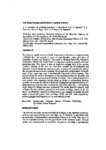Please use this identifier to cite or link to this item:
http://www.alice.cnptia.embrapa.br/alice/handle/doc/1020673| Title: | Soil tillage systems and herbicide leaching in Brazil. |
| Authors: | CERDEIRA, A. L.  SOUZA, M. D. de   BOLONHEZI, D.   QUEIROZ, S. C. do N. de   FERRACINI, V. L.   LIGO, M. A. V.   PESSOA, M. C. P. Y.   SMITH JR, S.   |
| Affiliation: | ANTONIO LUIZ CERDEIRA, CNPMA; MANOEL DORNELAS DE SOUZA, CNPMA; D.BOLONHEZI, IAC; SONIA CLAUDIA DO N DE QUEIROZ, CNPMA; VERA LUCIA FERRACINI, CNPMA; MARCOS ANTONIO VIEIRA LIGO, CNPMA; MARIA CONCEICAO PERES YOUNG PESSOA, CNPMA; S. SMITH JR, USDA/ARS - National Sedimentation Laboratory. |
| Date Issued: | 2005 |
| Citation: | In: ANNUAL MISSISSIPI WATER RESOURCES CONFERENCE, 35.; SYMPOSIUM ON SAFE MANAGEMENT AND UTILIZATION OF ANIMAL SAFE, 2., 2005, Cabot Lodge Millsaps, Jackson, MI. [Proceedings…] Cabot Lodge Millsaps, Jackson, MI: GRI, 2005.. p. 1-7. |
| Description: | The Guarany aquifer located in South America has a dimension of approximately 1,200,000 Km2 and spreads to areas of eight Brazilian states plus parts of Argentina, Uruguay and Paraguay. The region of Ribeirao Preto City, located in Southeast of Brazil, Sao Paulo State, is a sugarcane, soybean, peanuts, and corn producing area. This region is also an important recharge area to the aquifer. Intensive farming on the area has demanded constant use of herbicides and fertilizers. Triazine herbicides such as atrazine, ametryn, and simazine are used on the area and are known to have potential for groundwater contamination. Currently most of the sugar cane crop is mechanically harvested without burning. This practice allows the straw to decompose in soil, maintain a better soil structure, and interferes with the movement and leaching of solutes. It is a common practice to sow peanuts after sugarcane harvest using no-tillage or conventional planting systems. To evaluate the effects of herbicide leaching into groundwater during notillage planting of peanut after mechanically harvested sugarcane, a soil leaching study using soil columns has been conducted. The results showed a general trend of higher density and lower porosity in soils under no-tillage, mainly at the top layer. The Hydraulic Conductivity determined in soil columns was higher for soils under conventional system than no-tillage, 10.82 and 4.59 cm/h respectively,indicating higher leaching potential for conventional system. |
| Thesagro: | Águas subterrâneas Hidrologia |
| NAL Thesaurus: | Groundwater Hydrology Soil transport processes Nonpoint source pollution |
| Type of Material: | Artigo em anais e proceedings |
| Access: | openAccess |
| Appears in Collections: | Artigo em anais de congresso (CNPMA)  |
Files in This Item:
| File | Description | Size | Format | |
|---|---|---|---|---|
| 2005AA041.pdf | 1,5 MB | Adobe PDF |  View/Open |









